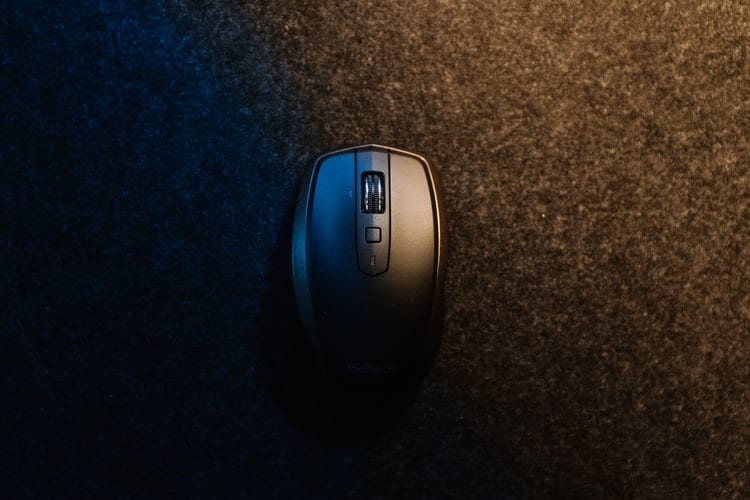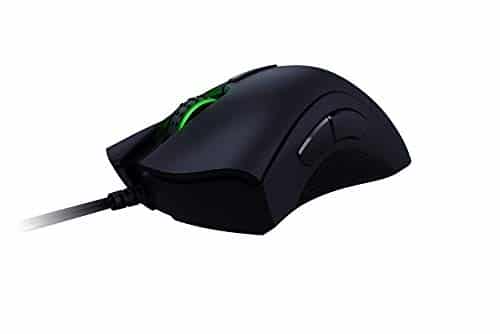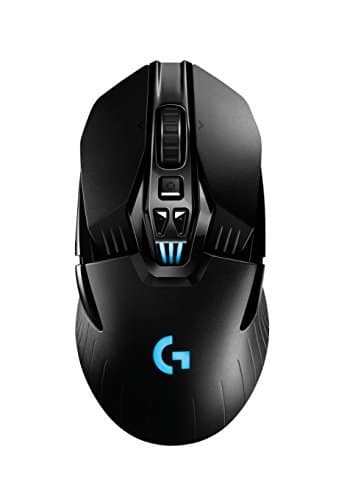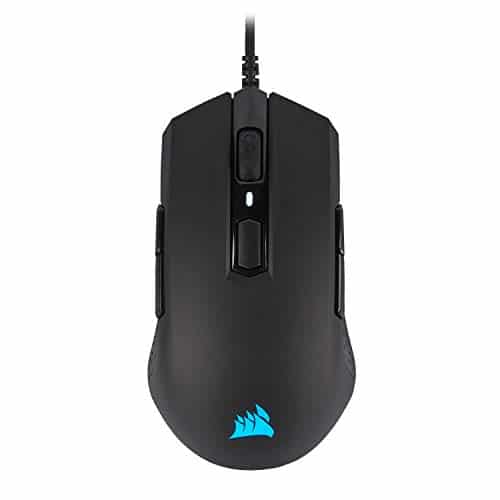The 5 Best Left-Handed Gaming Mice Reviewed

Research suggests that between ten and twelve percent of the world’s population is left-handed. So why is it that lefties still struggle to find products designed specifically for them?
We’ve come a long way from accusing left-handed people of witchcraft, but we could do a lot more too.
If you’re left-handed, you’ll understand the struggle that comes with using scissors, desks, and can openers.
If you’re a gamer, you’ll also know how difficult it can be to find a mouse that you can hold comfortably.
Fortunately, some left-handed and ambidextrous gaming mice do exist. In this article, we will take a look at the best gaming mice on the market at the moment for left-handed people.
Read on to our extensive Buyers’ Guide to help you make the right decision.
Best Left-Handed Gaming Mice
1. Razer Deathadder Left-Handed Edition
Our top pick had to be the left-handed edition of the Razer Deathadder gaming mouse. We love it as it’s one of the only true left-handed gaming mice on the market.
This mouse is unique as it is specifically only designed for left-handed people. It can be compared to the much-loved Razer Deathadder essential as it has similar specs.
This mouse comes complete with a 3,500 DPI infra-red sensor, five programmable Hyperesponse buttons, 1ms response time, gold plated USB connector, and a braided cable.
It’s considered a medium-sized mouse and weighs 148g, which is a little on the heavy side.
As it’s a Razer mouse, you know you’re guaranteed a top-quality gaming experience.
If used with a good mousemat, it should provide a smooth and effortless gaming experience with an excellent grip.
It also comes with five programmable side buttons which enable you to customize your gameplay.
However, the only downside is the price. It’s quite an expensive option, but many Amazon reviewers claim that it is worth the money.
- Gaming mouse with one of the world's enhanced optical sensor with true 16000 DPI, 450 IPS and 99 4 percent resolution accuracy
- Gaming optimised razer mechanical mouse switches durable up to 50 million clicks
- Ergonomic form factor has been tested and validated by top esports athletes
- Gaming grade tactile scroll wheel for high control
- DPI buttons at your fingertips and razer chroma customisable lighting
2. Logitech G903
Next up is the G903 model made by Logitech. While this mouse isn’t specifically designed for left-handed people, very few gaming mice are.
Instead, it’s considered an ambidextrous mouse. However, it’s still intelligently shaped for maximum comfort. It also features fully programmable buttons.
Some gamers who bought this mouse mentioned the high-quality buttons and how they’re very clean and satisfying to press.
The scroll wheel is made from metal which can be clicked, spun, or even used as a notch button. It uses Logitech’s famous 12,000 DPI sensor, too.
The Logitech G903 is a great option for lefties and right-handed people alike. It’s a wireless mouse so you can avoid annoying cable interference.
However, if you don’t want to have to keep charging it up or changing the batteries, it comes with a wire so you can use it as a wired mouse whenever you please.
- LIGHTSPEED WIRELESS: latency can be the difference between winning it all or losing. LIGHTSPEED wireless technology features a 1 ms report rate for competition level twitch targeting
- ADVANCED PMW3366 SENSOR: equipped with the PMW3366 optical sensor zero smoothing, filtering, or acceleration across the entire DPI range (200 12,000DPI) at speeds over 400 IPS
- ADVANCED MECHANICAL BUTTON TENSIONING: delivers an exceptionally clean and crisp button feel, response, and consistency. Battery Life: Default lighting: 24 hours, No lighting: 32 hours
- POWERPLAY Wireless Charging Compatible: the world's first and only wireless gaming mouse charging system, to keep G903 (and G703) charged while at play and at rest. Max acceleration >40G3. Cable length - 1.80 m
- CUSTOMIZABLE DESIGN: configurable button layout and ambidextrous design allow for left or right handed use that works with nearly any mouse grip style, including palm, claw and fingertip grips
3. Corsair M55 RGB Pro
Our next pick is another ambidextrous gaming mouse. The Corsair M55 RGB Pro manages to cater to both left and right-handed people alike.
It’s also super comfortable and easy to use thanks to its lightweight design which comes in at just 89g.
You can use the programmable buttons along the side of the mouse to switch back and forth between left and right-handed mode.
The M55 RGB Pro comes complete with high-quality grips, a responsive optical sensor (up to 12,400 DPI), and customizable DPI profiles.
Possibly the most attractive aspect of this mouse is its price tag. It’s an extremely affordable option compared to our first two products on this list.
However, the price of this mouse does mean you have to compromise on quality, so expect a couple of flaws below the surface.
- Play at your highest level with a versatile ambidextrous design that lets you game in either hand with your most comfortable grip, be it Palm, claw, or fingertip.
- Take precise control over your gaming thanks to a 12, 400 DPI optical sensor for high-accuracy tracking.
- Incredibly lightweight at just 86G, so that you can play effortlessly at your top form for hours.
- Durable construction featuring 50 million click-rated Omron switches and a premium braided cable gives the M55 RGB Pro the strength to withstand years of intense gaming sessions.
- Create an in-game advantage with eight fully programmable buttons for powerful macros and Remaps.
4. Razer Lancehead
Our next addition to this list is yet another Razer mouse. The Razer Lancehead is a fantastic wireless option for a left-handed gaming mouse.
Unlike the Deathadder, which is our Top Pick, the Lancehead features rubber grips along the sides. These grips promote a comfortable and smooth gaming experience.
It comes complete with a whopping five programmable buttons, a 16,000 DPI sensor, and a battery life of up to 24 hours.
This mouse can be considered medium-sized and weighs in at 111g. However, one issue with this mouse is that the button placement can’t be changed, but over time you’ll become used to their position and shouldn’t find yourself pushing them accidentally.
As this is a wireless mouse from a reputable brand, it’s a little on the pricey side. If you want to save a few bucks, consider checking out the Lancehead Tournament, which is considered to be the closest wired alternative.
- High-precision 16, 000 DPI optical sensor: offers on-the-fly sensitivity Adjustment through dedicated DPI buttons (reprogrammable) for gaming and creative work
- Ambidextrous design: Created for left and right-handed users with accessible, programmable buttons on both sides
- Customizable Chroma RGB color profiles: includes 16.8 million color combinations w/ included preset profiles
- Ridged, rubberized scroll wheel for maximum accuracy: small, tactile bumps increases grip and allows for more controlled scrolling in high-stakes gaming situations
- 9 programmable buttons: allows for reconfiguration and assignment of complex macro functions through Razer Synapse
5. SteelSeries Sensei 310
Our final gaming mouse on this list could be considered a hidden gem. The SteelSeries Sensei 310 has some fantastic features packed inside its small shell that is often overlooked.
Its new and improved design includes comfortable ergonomic grips and a comfortable, ambidextrous shape.
The Sensei 310 has two symmetrical thumb buttons on each side of the mouse which can be quite annoying if you find yourself pushing them accidentally.
If you’re on the hunt for an affordable, medium-sized, and lightweight left-handed gaming mouse, this is a great option to consider.
- Custom TrueMove3 12,000 CPI, 350 IPS optical 1-to-1 tracking esports sensor
- Legendary SteelSeries Sensei ambidextrous design for claw and palm grip styles
- Two-zone, multi-color Prism RGB illumination for customizable lighting. Save all your performance and lighting settings directly to the Sensei 310
- Compatible operating system is windows, mac, and linux. Usb port required. Software is steelseries engine 3.10.12 plus, for windows 7 or newer and mac osx 10.8 or newer
Buying Guide for Left-Handed Gaming Mouse
It can be difficult to know what gaming mouse to buy anyway, but this is made even more difficult if you’re left-handed.
You’ll have to consider several factors including your gaming style, sensor type, sensitivity, grip, and wire. Here’s why.
Gaming style
When shopping for a gaming mouse, taking into consideration the type of games you like to play is a good idea.
Every game will have different requirements for a mouse, some games tend to focus more on accuracy and precision while others focus on speed.
Precision is especially important when playing First Person Shooter games such as Call of Duty. For games like this, look for an accurate and reliable mouse.
If multiplayer online battle games are more your bag, such as World of Warcraft, then consider looking around for a mouse that has programmable buttons on the side.
These allow you to perform certain actions during gaming and can be used as hotkeys.
Sensor
There are two key types of sensors that you will find in a gaming mouse; optical and laser. The way that optical and laser mice track movement is different.
Optical mice use an LED light, whereas laser mice have a laser for movement detection. Optical sensors are the most common type of sensor found inside gaming mice.
Each type of sensor has its own advantages and disadvantages.
Optical mice are favored among the gaming community for many reasons. The first being their price.
Optical mice are typically far cheaper than laser mice, making them appealing to those on a lower budget and the younger generation of gamers.
They’re also far less jittery than laser mice which makes them better for games that need precise aim.
However, optical mice can only be used on opaque, non-reflective, flat surfaces such as wood or mouse mats.
Laser mice can be used on any surface. This includes lacquered surfaces and even glass, thus making them a more portable option than their competitor.
While laser mice are considered more accurate than optical ones, they’re not as effective when it comes to more intricate and small movements.
They can sometimes overanalyze the surface that they’re on which results in jittering. This is particularly inconvenient for gamers.
Polling Rate
Polling rate is a measure of how often your mouse reports back to your computer in hertz (Hz). If your gaming mouse has a 2oo Hz polling rate, it means it reports its position 200 times every 1 second, which is quite a lot.
High-quality mice will usually have a polling rate of at least 500 Hz. It’s important to remember that a mouse with a high polling rate will use up more CPU resources than one with a low polling rate.
Lift-Off Distance (LOD)
Lift-off distance refers to the point at which an optical or laser mouse sensor stops tracking movement after you pick it off a surface.
A low lift-off distance allows you to recenter your mouse.
For example, if you’ve reached the edge of your mouse pad, it will find its way back without making unintended movements on the screen. It is especially useful if you prefer to play with your gaming mouse set at a low sensitivity/DPI.
Acceleration
The acceleration of a mouse refers to how fast the cursor on the screen moves with your hand moving the mouse.
So if you have a mouse with better acceleration, you’re going to be able to complete your action more quickly and without lots of unwanted mouse movement.
However, too much acceleration can make gaming difficult because it makes it harder to gauge the speed of your movements on the screen.
This results in your gameplay being inconsistent. To remedy this, we recommend disabling mouse acceleration before gaming.
Grip
As a lefty, you’re probably familiar with how difficult it can be to grip certain objects comfortably. Luckily, left-handed mice with good quality grip do exist.
Choosing the right style of grip is important as it can ultimately determine the size and shape of it. The three most common styles of grip are palm, claw, and fingertip.
Claw grips are usually found on mice that are short and rounded on the back. To hold a mouse with a claw grip you arch your middle and index fingers to form a claw and leave your palm resting on the top of the mouse.
A claw grip is particularly good at providing wrist control if that’s what you’re looking for.
The palm grip involves resting most of your fingers and palm on the mouse, providing arguably the most comfort out of all of the grip types.
If you’re a fan of this grip style or use a lot of gliding motions with your mouse, look for a longer and bulkier gaming mouse. These usually feature the palm grip style.
The fingertip grip involves arching your entire palm until it is slightly suspended above the mouse. Your fingertips should be the only part of your hand touching the mouse.
The fingertip grip style is ideal for making fast movements. To get the most out of it, look for a lightweight mouse. Ideally, this should weigh less than 100g
Frequently Asked Questions
Should I buy a wired or wireless gaming mouse?
If you’re using a wireless gaming mouse, you’re not tethered to anything so you’re free from cable drag and you’ll have no pesky wires in the way.
Wireless mice are also great for portability. However, they will need to be recharged often, which can get annoying. Wired gaming mice are typically favored among gaming professionals.
This is because they have a faster response time than wired ones. If the games that you like to play don’t require you to have a fast response time, then a wired mouse probably isn’t essential.
We recommend figuring out your game style before deciding whether to choose a wired or wireless gaming mouse.
How much should I be spending?
When looking for the ideal mouse it’s important to consider what features are most important to you so that you can prioritize them.
Fortunately, a good gaming mouse with a long life can cost as little as $40. Lower prices sacrifice some quality but will still work well.
For the higher quality mice, you should look in the region of $50+, with higher prices offering extra features.
However, most of these features aren’t absolutely necessary for everyone, so make sure it’s worth the splurge.


![Razer Deathadder Elite Gaming Mouse (chroma Multi-Color, 16,000 DPI Sensor and Razer mekanikarumaususuitti with Esports Mouse) [parallel import goods]](https://m.media-amazon.com/images/I/311B1zMmf0L.jpg)







